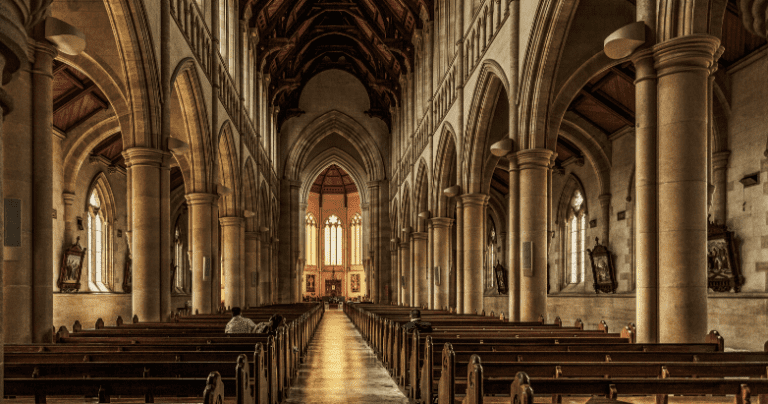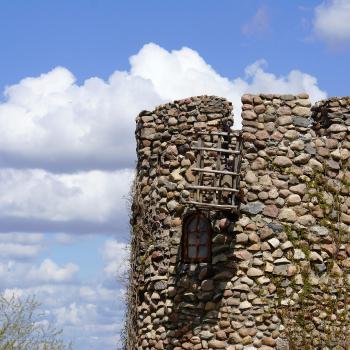Monday: Read 12:41-14:9
The larger context for Mark 12:41-14:9 includes the fact that Jesus entered Jerusalem and the temple and He found no fruit (11:11-14). As a result, He pronounces a coming judgment on the Temple by overturning the tables in the temple courts (11:15-18).
The episode of the woman giving her two “copper coins” (note Mark always translates Judean language for his Roman readers: thus, he says, “which amount to a cent”; 42) has been widely misunderstood. Jesus is not heralding the woman as a hero. He is not addressing her at all. Instead, He is rebuking the religious leaders for making her give. After all, she gave “all she had to live on” (44). This means that she didn’t have enough left over to buy a loaf of bread! And they were mandating that she give: even though those who benefitted from her offering had plenty to live on! Jesus could not have been happy about this. Just prior to this account, He told His disciples, “Beware of the scribes . . . who devour widows’ houses” (38, 40). Surely the story of this woman illustrates them doing just that!
This sets the context for the famed “Olivet Discourse” (13:1-37). In this speech, Jesus reiterates that the temple will be destroyed (13:1-2). The disciples then ask, “when will these things be?” (13:3). Jesus’ speech is a response to this question and primarily addresses the signs that will accompany the impending destruction of the Temple (which occurred in AD 70). As for Jesus’ return, which the disciples had no clue what that meant, Jesus says that He doesn’t know when it will occur (32). The speech concludes in 13:33-37. Note that these verses are framed with “keep on the alert” (33, 37).
I intentionally included the woman giving at the temple (12:41-44) and woman anointing Jesus 14:3-9 with our reading of 13:1-37. It is conceivable that the two accounts of women serve as the outer part (the bread) of a Marcan sandwich—with chapter 13 as the center (the peanut butter and jelly). There are numerous parallels between the accounts of the two women: in both accounts the gift is specified (2 coins; 300 denarii); both use the word “poor” (12:42-43; 14:5, 7). And both are stories of women worshiping at the temple: i.e., the woman who anoints Jesus is worshiping at the new Temple! In the middle is Jesus’ speech on the coming destruction of the Jerusalem temple.
For a detailed discussion of Mark 13 and the end-times see my Understanding the New Testament and the End Times, chapter 10.
For a somewhat different viewpoint than mine, see Alexander Stewart Jesus and the Future, part 1.
Questions to ponder/discuss:
- What evidence do you see in 13:1-37 that supports the view that most of this chapter relates to events that occurred at the time of the disciples? Note Jesus’ commands to the disciples. How many can you find?
- What do you think “keep watch” means? (We will address this question again in our study of Matt 25).
- What do you think worshiping Jesus as the new temple looks like today?
Tuesday: Read 14:10-52
Yet again we stumble upon a Marcan sandwich (1-11). The sandwich begins with yesterday’s reading and the conspiracy to kill Jesus (1-2). It closes with Judas’ agreement to betray Jesus leading to His death (10-11). In the middle is the woman’s anointing Jesus in preparation for His burial (3-9).
Judas’ agreement to betray Jesus (10-11), then, forms the beginning of another sandwich. This sandwich ends with reference to one of the disciples betraying Jesus (17-21). In the center the disciples prepare for the Passover meal (12-16).
But this is not the end of Mark’s sandwiches. Jesus’ informing the disciples that one of them would betray Him (17-21) begins another. This sandwich closes with Jesus’ warning that they will all fall away (27-31). In the middle is the Last Supper (22-26). In this sandwich, one of the disciples betrays Him, they all fall away, yet Jesus remains faithful unto death. The self-sacrifice of Jesus contrasts with the betrayal of the disciples.
The Last Supper must be understood as a meal in which Jesus reconstitutes the new Israel: hence, “this is My blood of the Covenant” (24; cf Jer 31:31-34). The present passage has echoes of the Israelites leaving Egypt. The importance of this is the awareness that what follows for them (and us) is an experience in the wilderness. Leaving Egypt will not be easy, and neither will be the wilderness experience that awaits them/us. Thus, Jesus repeatedly instructs his disciples to “keep watch” through the night (34, 37, 38). Even Jesus prays that the hour might “pass Him by” (35).
For further reading see Perrin, Nicholas, Jesus the Priest
Questions to ponder/discuss:
- It is easy to read these stories and think “we would have done better than the disciples.” Right?! We would never betray Him for money. We would certainly have faced arrest and death for Him. Think of a time in which you had an opportunity to be faithful to Christ and you didn’t stand firm; then repent and pray that Christ might show you what being faithful to Him might look like each day, and ask for the power of the Spirit to do so.
Wednesday: Read 14:53-15:15
Perhaps the most significant sandwich occurs in the trial scene. First, Peter enters the home of the High Priest (53-54). In the center is Jesus before the Sanhedrin (55-65). The scene ends with Peter’s denials (66-72). Jesus’ faithfulness contrasts Peter’s weakness.
The trail scene is significant as it testifies that Jesus was indeed making assertions regarding the Temple. Even though they could not find a consistent testimony (59), we know that their basic charge was correct: Jesus indeed claimed to be the true temple (John 2:19-21).
The release of Barabbas certainly contrasts Jesus’ death. The contrast is evident first in that there is no way that the man’s name was “Barabbas” (lit., “a son of a father”). No person would be named this. It is quite likely that the disciples gave him this nickname in their later retelling of the story. There is some evidence that suggests that Barabbas’ real name was “Jesus.” It is possible, then, that the early Christians gave him the nickname Barabbas as a way of contrasting “Jesus, barabbas’: (Jesus, a son of a Father) with “Jesus, barabba” (Jesus, the Son of the Father). Regardless, the irony is deep: a convicted murderer is set free, while an innocent man is killed.
Questions to ponder/discuss:
- It is easy to look down on Peter as one who denied Jesus: “there goes Peter again.” But the reality is that he is one of the few that even stuck around at all. Why do you suppose Peter lied about knowing Jesus? What might you do to be more prepared so that when the opportunity comes to acknowledge Jesus, you won’t give in and deny Him?
Thursday: Read 15:16-39
Biblical scholar Michael Bird pointed out that Mark’s Gospel narrates Jesus’ crucifixion as a parody of the Roman triumph. A Roman triumph is a formal ceremony in Rome that occurs after a successful military campaign. The conquering general would first be arrayed in a purple robe (17). Then they would place a laurel wreath on his head (17). The general would then march into Rome with his two sons or two generals traveling next to him (27). They would then offer the victorious general a drink, which he would refuse (23). When the procession ended the victorious general would be proclaimed, the “son of Jupiter.” Jesus, of course, is proclaimed the Son of God” (39). If Mark is mimicking the Roman triumph, then surely he is setting forth Christ as the world’s true King.
As we noted earlier, the Gospel of Mark begins with Mark’s claim that Jesus is “the Son of God” (1:1). This statement had significant political overtones. After all, only Caesar was “a son of the gods.” The fact that the Gospel of Mark closes with a Roman centurion confessing Jesus: “truly this man was the Son of God” (39),[2] highlights the political nature of Jesus’ claim. Jesus is the King! Caesar is not!
Listen to/meditate on the lyrics to “This is how love wins” by Steven Curtis Chapman.
Questions to ponder/discuss:
- Rom 5:8 says that He died for us while we were His enemies. It is easy to read the crucifixion accounts and think about what “others” (the Sanhedrin, Pilate, the Romans) did to Jesus. But the reality is that we participated too. What is the significance of Jesus’ death for you?
- The death of Jesus is certainly to be viewed as a substitutionary event. Jesus died in our place. It is also the moment of His victory. But it is also a demonstration of what “bearing your cross” looks like. We, too, must carry our crosses. In what area of life do you need Christ’s help to “carry your cross?”
- That Jesus is the true Son of God heralds Him as the true humanity (Adam was the son of God: Luke 3:38). Jesus’ death makes possible our resurrection. How does living in light of the death and resurrection of Christ impact your daily walk with Christ?
Friday 15:40-16:8 (9-20)
The section begins (40-41) by referring to a group of women who were watching from a distance. These women, as it turns out, used to “follow Him” (41). Of course, to “follow” Jesus is a key indicator in the Gospel of Mark of being a disciple (Mark 8:34). Mark also notes that they used to “serve Him” (my translation. The NAS, ESV, and NKJ say, “minister(ed)”; other translations say, “cared for His needs”: NIV; and “give Him support”: NET). The word used here is the verbal form of the word for “deacon.” It means to “serve” or “care for” (lit. “to wait on tables”). Certainly, the role of “deacon” does not exist yet. Nonetheless, the women are given a very high status by Mark. They were certainly disciples of Jesus and their “serving” Him models later Christian activity (This contrasts the way men and the disciples are portrayed in the Gospel of Mark).
This final section in the Gospel of Mark contains another sandwich. The account begins with reference to the women (40-41). Then Mark depicts Joseph’s burying of Jesus—an act that surely meant he would no longer be permitted to retain his status within the Jewish high council (42-46). Mark, then, returns to note that some of the women were watching the burial (47). Who are the faithful disciples?
The Gospel of Mark ends with an account of the women at the tomb on Sunday morning. An angel announces that Jesus has risen and they are to, “go, tell His disciples and Peter, ‘He is going ahead of you to Galilee; there you will see Him, just as He told you’” (15:7). That the Gospel ends with the women seemingly not obeying the command or of any description of Jesus appearing to the disciples in Galilee, suggests that Mark 15:8 is not the true end of the Gospel.
It is highly likely that the ending of Mark which we have in our modern Bibles (15:9-20), though certainly old, is not the correct ending. All we can assume is that the real ending was lost. Fortunately, we have Matthew, Luke, John, and even Paul to help us fill in the details.
Questions to ponder/discuss:
- As we will see throughout the NT, the resurrection of Jesus is the central pillar of Christianity (1 Cor 15:3-8). Without it, there is no Christianity. What does belief in Jesus’ resurrection do for your faith in Christ?
- The resurrection of Jesus, who is called the “Firstborn of the dead” (Rev 1:5), is a prelude to our resurrection (and the restoration of the whole of creation, but we will save that conversation for the book of Romans) and reminds us that eternity is not some spiritual, disembodied, heavenly bliss. We will live on the restored earth in bodies of flesh and dwelling in the eternal presence of God—whose “face” we will see (Rev 22:4). How does/should this impact your everyday life in Christ?
To receive auto-updates when new posts go live sign up for the newsletter on the top right-hand side of the homepage.
NB: My goal is to keep these posts free of charge. I do not intend to ever hide them behind a paywall. I can only do this if those of you who have been blessed by them and can afford to give ($5, $10, $25, or more/month) do so. You can give a tax-deductible contribution by following this link.
Please share this post and let others know about determinetruth.
If you wish to view this blog on your smartphone through the Determinetruth app simply download the “tithe.ly church” app on your smartphone and insert “determinetruth” as the church name you wish to follow. Once it is loaded, simply click on the “blog” icon and they will automatically load.
If you would like to have Rob speak at your church or organization in person or via zoom, please let us know by filling out the contact info on the Contact me tab on this site.
[1] This guide is meant to be done either as a group study over the course of 2 or 4 meetings (Day 1-5; 6-10; 11-15; 16-20) or as a private devotion over the course of 4 weeks (or a calendar month—5 lessons per week).
[2] Of course, one might suggest that the centurion meant by this that Jesus was “a son of the gods.”













